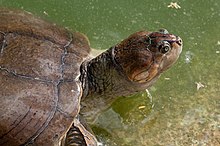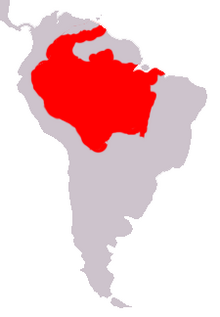巨型側頸龜
巨型側頸龜(學名:Podocnemis expansa)是南美側頸龜屬的一種龜[2][3]。它是最大的側頸龜,也是拉丁美洲最大的淡水龜類[3]。它是一種素食動物,會集群在沙灘上築巢[3]。由於人類的過度捕捉和環境破壞,其數量急劇下降[3][4][5][6]。
| 巨型側頸龜 | |
|---|---|

| |

| |
| 科學分類 | |
| 界: | 動物界 Animalia |
| 門: | 脊索動物門 Chordata |
| 綱: | 爬蟲綱 Reptilia |
| 目: | 龜鱉目 Testudines |
| 亞目: | 側頸龜亞目 Pleurodira |
| 科: | 南美側頸龜科 Podocnemididae |
| 屬: | 南美側頸龜屬 Podocnemis |
| 種: | 巨型側頸龜 P. expansa
|
| 二名法 | |
| Podocnemis expansa Schweigger, 1812
| |

| |
| 異名 | |
| |
分佈
編輯它分佈於巴西、玻利維亞、秘魯、厄瓜多、哥倫比亞、委內瑞拉和圭亞那的亞馬遜河、奧里諾科河和埃塞奎博河流域[2],在發洪水的時候也會出現在特立尼達[3]。水質渾濁與否對其影響不大。[7]
特徵
編輯其體重可達90公斤(200磅),龜甲長可達1.07米(3.5英尺)[8]。但實際上它們一般長不到那麼大,雌性甲殼長一般就在64—71 cm(2.1—2.3英尺)之間,雄性則在40—50 cm(1.3—1.6英尺)之間[3]。除去體型的差異,雄龜的尾巴更長[8]。其甲殼顏色有褐色、灰色、橄欖綠等[8],會根據食物不同而變化[3]。
習性
編輯巨型側頸龜在日間活動,以果實、種子、樹葉和水藻為食[8],偶然也會吃淡水海綿、動物的卵和屍體[3][8][9]
繁殖
編輯它們在水中交配[9],集群在沙灘上產卵[8],種群數量可達500隻[9]。雌性在交配季節喜歡在沙灘上曬太陽,這可能有助於它們排卵[10],但平時它們並不會這麼做[10]。雌龜很警覺,在受到驚嚇後會迅速撤回水中[3]。
雌龜在夜間產卵,它們會挖60—80 cm(2.0—2.6英尺)深的坑,一次產入75至120多枚卵[6]。它們一般在枯水期產卵,等河水上漲之後幼龜就會孵化。在沒有被捕食者干擾的情況下,每個巢穴的孵化率在83%左右[6]。卵的孵化需要50天左右,幼龜性別和環境溫度有關,高溫則產雌性,反之為雄性[3][8]。幼龜長5 cm(2英寸),並迅速入水。但由於各種捕食者的存在,最後能活下來的不過5%[11]。幼龜仍然集體生活[12],雌龜會發出特別的聲音來吸引幼龜。實際上,巨型側頸龜至少可以發出五種不同的聲音來傳遞不同的信息[12]。 野生的巨型側頸龜壽命可超過20歲,飼養狀態下至少可以活到25歲以上[3],其壽命上限可能在80歲左右。[13]
保護
編輯這種龜並沒有被IUCN視為瀕危物種[1],但其種群數量確實在大幅下降[10]。它們生長比較緩慢,雌龜需要4到8年才能達到性成熟(部分學者甚至認為需要17年[13])[3],它們固定在一個沙灘上產卵的習性也令它們更容易被人類捕獲[3]。1800年奧里諾科河上至少有33萬隻築巢的雌龜,但1945年數量已經減半,2000年代可能就只有700–1300隻了[4]。此外水質污染、修築大壩等行為都是造成其數量減少的元兇。巴西、哥倫比亞等部分國家已開始立法保護巨型側頸龜和他們產卵的沙灘,委內瑞拉則會收集龜卵進行人工孵育,但非法捕捉巨型側頸龜和採集其卵的行為並未停止[14][15]。
參考文獻
編輯- ^ 1.0 1.1 Tortoise & Freshwater Turtle Specialist Group. Podocnemis expansa. The IUCN Red List of Threatened Species (IUCN). 1996, 1996: e.T17822A97397263. doi:10.2305/IUCN.UK.1996.RLTS.T17822A7500662.en.
- ^ 2.0 2.1 Rhodin, Anders G.J.; Inverson, John B.; Roger, Bour; Fritz, Uwe; Georges, Arthur; Shaffer, H. Bradley; van Dijk, Peter Paul. Rhodin A G.J.; Iverson J.B.; van Dijk P.P.; Saumure R.A.; Buhlmann K.A.; Pritchard P.C.H.; Mittermeier R.A. , 編. Turtles of the world, 2017 update: Annotated checklist and atlas of taxonomy, synonymy, distribution, and conservation status(8th Ed.) (PDF). Chelonian Research Monographs. Conservation Biology of Freshwater Turtles and Tortoises: A Compilation Project of the IUCN/SSC Tortoise and Freshwater Turtle Specialist Group 8. August 3, 2017, 7: 1–292 [October 4, 2019]. ISBN 978-1-5323-5026-9. doi:10.3854/crm.7.checklist.atlas.v8.2017. (原始內容存檔 (PDF)於2021-02-25).
- ^ 3.00 3.01 3.02 3.03 3.04 3.05 3.06 3.07 3.08 3.09 3.10 3.11 3.12 Rivas, D. Podocnemis expansa (Arrau Sideneck Turtle) (PDF). The Online Guide to the Animals of Trinidad and Tobago. 2015 [28 September 2017]. (原始內容存檔 (PDF)於2017-09-29).
- ^ 4.0 4.1 Mogollones, S.C.; D.J. Rodriguez; O. Hernandez & G.R. Barreto. A Demographic Study of the Arrau Turtle (Podocnemis expansa) in the Middle Orinoco River, Venezuela. Chelonian Conservation and Biology. 2010, 9 (1): 79–89. doi:10.2744/CCB-0778.1.
- ^ Overduin, M. More Than 1,000 Turtles and Nests Protected in Colombia. Turtle Survival Alliance. 2 September 2015 [28 September 2017]. (原始內容存檔於2018-08-30).
- ^ 6.0 6.1 6.2 Vanzolini, P.E. On clutch size and hatching success of the South American turtles Podocnemis expansa (Schweigger, 1812) and P. unifilis Troschel, 1848 (Testudines, Podocnemididae) (PDF). Anais da Academia Brasileira de Ciências. 2003, 75 (4): 415–430 [2020-04-25]. PMID 14605677. doi:10.1590/s0001-37652003000400002. (原始內容存檔 (PDF)於2017-08-15).
- ^ Alves, R.R.N. & G.G. Santana. Use and commercialization of Podocnemis expansa (Schweiger 1812) (Testudines: Podocnemididae) for medicinal purposes in two communities in North of Brazil. Journal of Ethnobiology and Ethnomedicine. 2008, 4 (3): 3. PMC 2254592 . PMID 18208597. doi:10.1186/1746-4269-4-3.
- ^ 8.0 8.1 8.2 8.3 8.4 8.5 8.6 Podocnemis expansa. INCT CENBAM, INPA. [28 September 2017]. (原始內容存檔於2020-02-17).
- ^ 9.0 9.1 9.2 Rivas, D. Arrau turtle. Oregon Zoo. [28 September 2017]. (原始內容存檔於29 September 2017).
- ^ 10.0 10.1 10.2 Ferrara, C.R.; L. Schneider & R.C. Vogt. Podocnemis expansa (Giant South American River Turtle). Basking before the nesting season. 2010.
- ^ The Simon and Schuster Encyclopedia of Animals
- ^ 12.0 12.1 Ferrara, C.R.; R.C. Vogt; R.S. Sousa-Lima; B.M.R. Tardio & V.C.D. Bernardes. Sound Communication and Social Behavior in an Amazonian River Turtle (Podocnemis expansa). Herpetologica. 2014, 70 (2): 149–156. doi:10.1655/HERPETOLOGICA-D-13-00050R2.
- ^ 13.0 13.1 Hernandez, O. & R. Espín. Efectos del reforzamiento sobre la población de Tortuga Arrau (Podocnemis expansa) en el Orinoco medio, Venezuela. Interciencia. 2006, 31: 424–430.
- ^ Peñaloza, C.L.; O. Hernandez & R. Espín. Head-starting the Giant Sideneck River Turtle (Podocnemis expansa): Turtles and People in the Middle Orinoco, Venezuela (PDF). Herpetological Conservation and Biology. 2015, 10: 472–488 [2020-04-25]. (原始內容存檔 (PDF)於2018-04-10).
- ^ Pantoja-Lima; Aride; de Oliveira; Félix-Silva; Pezzuti & Rebêlo. Chain of commercialization of Podocnemis spp. turtles (Testudines: Podocnemididae) in the Purus River, Amazon basin, Brazil: current status and perspectives. J Ethnobiol Ethnomed. 2014, 10 (8): 8. PMC 3933064 . PMID 24467796. doi:10.1186/1746-4269-10-8.
外部連結
編輯- Forero-Medina, G.; et al. On the future of the giant South American river turtle Podocnemis expansa. Oryx. 2019: 1–8 [2020-04-25]. doi:10.1017/S0030605318001370. (原始內容存檔於2021-02-23).
